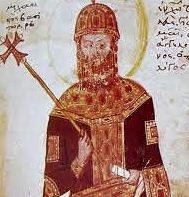
Recapture of Constantinople |
year: 126125 July 1261 |
| The Byzantines recaptured Constantinople after 57 years of Latin occupation | ★ ★ ★ ★ ★ |
|
enemy: Latins
|
location: Constantinople
|
accuracy:
●●●●●
|
|
battle type: City Capture |
war: Nicaean-Latin Wars |
modern country:
Turkey |
| ▼ The Byzantines(emperor: Michael VIII Palaiologos) | ▼ The Enemies | |
| Commander: | General Alexios Strategopoulos | Emperor Baldwin II of Constantinople |
| Forces: | 800 | Unknown |
| Losses: |
| Background story: |
| After the Fall of Constantinople to the Latins of the 4th Crusade in 1204, a first attempt was made by the Byzantines of Nicaea to recapture the capital in 1235 during the reign of John III Doukas Vatatzes.That attempt failed but under Vatatzes, the Nicaeans seized most of Thrace and Macedonia from Epirus and Bulgaria, becoming the strongest state of the region. Reduced to Constantinople and the territory immediately surrounding it, surrounded on east and west by Nicaea and without sufficient funds to attract any armed support, the Latin Empire seemed ripe for the taking by the time of Vatatzes' death. The Latin Empire gained a short reprieve with Vatatzes' death, as his son and successor Theodore II Laskaris (r. 1254–1258) was forced to confront numerous attacks on his territories in the Balkans. Soon after Theodore II's death, the ambitious Michael VIII Palaiologos ascended the throne, at first ostensibly as guardian of the infant John IV Laskaris (r. 1259–1261).With Michael Paleologos, Nicaea became the master of the game in the region, especially after the victory in the battle of Pelagonia, in the summer of 1259. Thus Michael VIII Palaiologos was now able to turn against Constantinople. An initial attempt in 1260, focusing on the Galata district, failed. But Michael was not intimidated. Although he made a peace treaty with the Latin emperor Baldwin II, he immediately began preparations for a new attempt to take the city. An additional motivation for Michael was certainly his desire to consolidate his position on the throne, which in 1259 was not yet stabilized, as he formally ruled with the rightful emperor, the minor John IV Laskaris. |
The Battle: |
 Michael VIII Palaiologos When this Byzantine force reached the village of Selymbria (60 km from the capital), Strategopoulos was informed from local farmers (thelematarioi –ex mercenaries) that the entire Latin garrison, and the Venetian fleet, were absent conducting a raid against the Nicaean island of Daphnousia. Although initially hesitant, due to both the small size of his force, which might be destroyed if the Latin army returned, and because he would exceed his orders, Alexios eventually decided not to lose such a golden opportunity to retake the city. On the night of July 25, 1261, Alexios and his men approached the city walls and hid at a monastery near the Pegae Gate. Alexios sent a detachment of his men, who, led by some of the thelematarioi, made their way to the city through a secret passage. They attacked the walls from the inside, surprised the guards and opened the gate, allowing the Byzantine force entry into the city. The Latins were completely taken by surprise and after a short battle, the Byzantines took control of the Land western walls. Then they advanced in the interior. Some of the Latin soldiers tried to resist and skirmishes ensued, which, however, did not prevent the Byzantines from quickly occupying most of the city. Many of the Greeks of the city enthusiastically welcomed the Byzantine soldiers. Stratigopoulos took advantage of their presence and put them on the walls to give the enemy the impression that he had invaded with a large army. Panic ensued between the Latins and the Venetians of Constantinople who rushed to the port, trying to find a ship and leave. The Latin emperor Baldwin II was at the palace of the Blachernae and ran to the seaside palace of Bucoleon from where he boarded a ship and departed for Evia. He was so upset that he forgot to take the imperial insignia with him. Stratigopoulos, acting prudently, let the Latins run to the shores without pursuing them and without harassing them. As there was an immediate danger of the return of the Venetian fleet from Daphnousia, Stratigopoulos ordered the burning of the Venetian and other Western quarters, which were located along the Golden Horn. When the Venetian fleet, consisting of 30 ships, returned, it could do nothing but rescue the Latins and sail to other Latin-occupied areas. It should be noted that the fleet was not prepared and did not have supplies with it, so the refugees suffered and many died on the journey from hardship and starvation. At the end of the day, Stratigopoulos has secured Constantinople. He gave the insignia of the Latin emperor to a messenger and sent him to Nicaea. Michael Paleologos learned the news from his sister Irene Evlogia Palaiologina and at first did not believe her. But when he saw the imperial emblems, he was convinced and left for Constantinople. |
Aftermath: |
| The recapture of Constantinople meant the restoration of the Byzantine Empire by the Nicaeans, and on August 15, the day of the Dormition of the Theotokos, Emperor Michael entered the city in triumph and was crowned at the Hagia Sophia. A new era for Byzantium started. |
|
|
